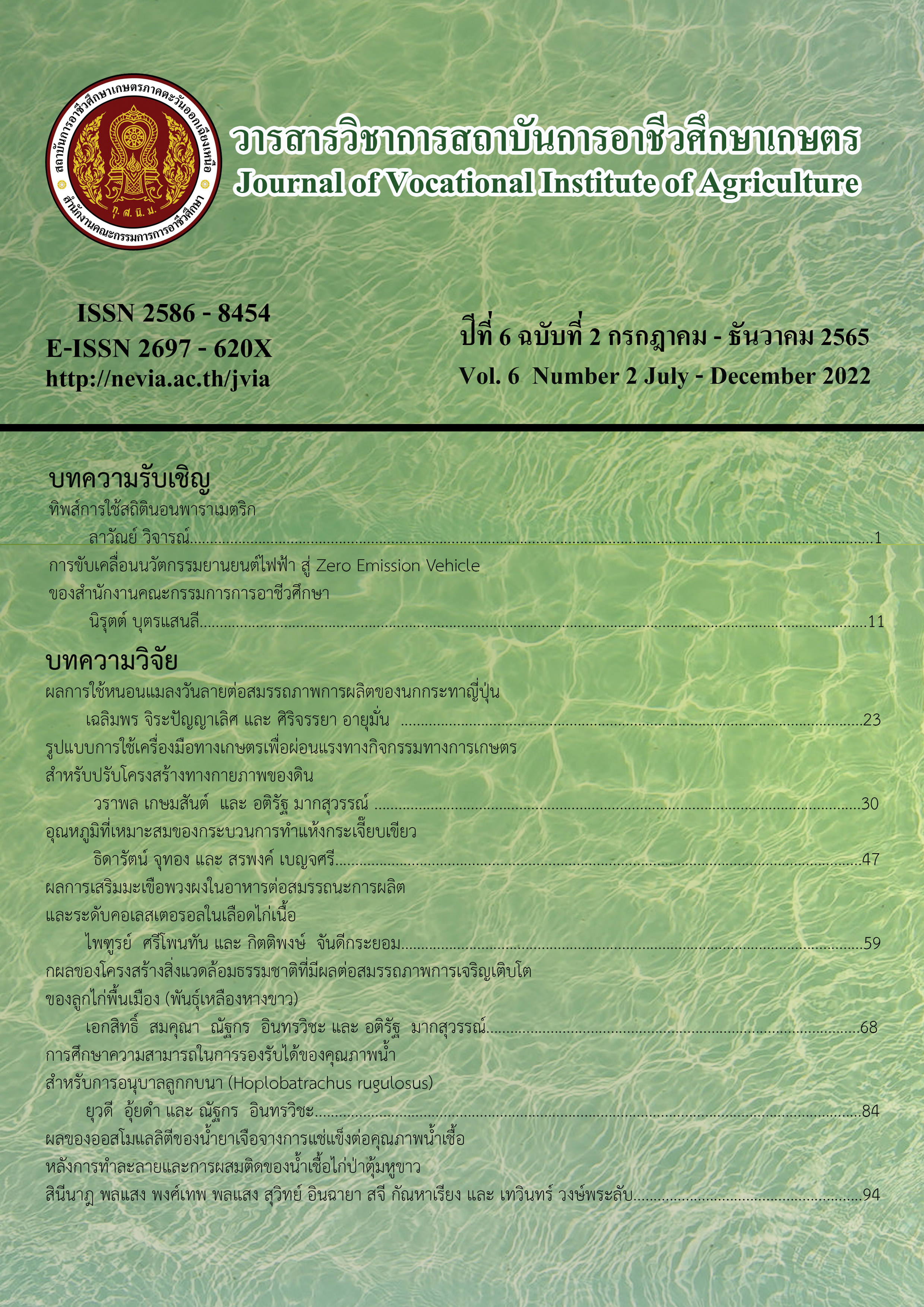Effects of Using Black Soldier Flies on Growth Performance of Japanese Quail
Main Article Content
Abstract
The objective of this research was to study the effects of using black soldier flies on production performance of japanese quail. This research was conducted by using Completely Randomize Design (CRD) with 3 treatments and 3 replications. The treatments were divided into 3 groups, T1: the japanese quails were fed with 21% of crude protein commercial feed for initial broiler (ad libitum)., T2: the quails were fed with the broiler feed mixed with black soldier flies (1:1 by weight) and T3: the birds were fed with black soldier flies. Ninety mixed gender Japanese quails, 14 days old, with an average weight of 34.67 g were used in this experiment. The experimental period was 28 days. All groups of bird were provided with feed and water ad libitum. The results showed that the birds in T2 had the highest average body weight at 135.80 g and average weight gain at 100.93 g. As for the ADG and FCR, it was found that the birds in T2 had the highest average ADG at 3.60 g/day and the lowest average FCR at 2.64. The experimental results showed that the growth rate of Japanese quails fed with broiler feed mixed with black soldier flies was higher than using only commercial feed or black soldier flies.
Article Details

This work is licensed under a Creative Commons Attribution-NonCommercial-NoDerivatives 4.0 International License.
The content and information in articles published in the Journal of Vocational Education in Agriculture are the opinions and responsibility of the article's author. The journal editors do not need to agree or share any responsibility.
Articles, information, content, etc. that are published in the Journal of Vocational Education in Agriculture are copyrighted by the Journal of Vocational Education in Agriculture. If any person or organization wishes to publish all or any part of it or to do anything. Only prior written permission from the Journal of Vocational Education in Agriculture is required.
References
ศิริพันธ์ โมราถบ. (2541). นกกระทาสัตว์เลี้ยงตัวเล็กน่ารัก. วารสารเกษตรใหม่สีสันชีวิตไทย, 3 (17), 41-48.
Martin, F. W., et al. (1998). Quail: an egg & meat production system. from http://www.echonet.org/.
Bovera, F., et al. (2015). Yellow mealworm larvae (Tenebrio molitor, L.) as a possible alternative to soybean meal in broiler diets. British Poultry Science, 56(5), 569-575.
Makkar, H. P. S., et al. (2014). State of the art on use of insects as animal feed. Animal Feed Science and Technology, 197, 1-33.
Bradley, S. W., et al. (1984). House fly oviposition inhibition by larvae of Hermetia illucens, The black soldier fly. Journal of Chemical Ecology, 10, 853-859.
กุลชาติ บูรณะ และทัศนีย์ แจ่มจรรยา. (2554). การติดตามขนาดประชากร การเพาะเลี้ยง และคุณค่าทางโภชนะของแมลงวันลาย. วารสารวิจัย มข. ฉบับบัณฑิตศึกษา, 11(1), 19-26.
สมควร โพธารินทร์ และคณะ. (2561). รายงานสรุปผลการดำเนินโครงการ ผลิตภัณฑ์จากหนอนแมลงวันลาย เพื่อผลิตปุ๋ยอินทรีย์ และอาหารสัตว์โปรตีนสูง ภายใต้โครงการ Innovation Hub-Agriculture&Food เพื่อสร้างเศรษฐกิจฐานนวัตกรรมของประเทศตามนโยบายประเทศไทย 4.0. กรุงเทพฯ: มหาวิทยาลัยเกษตรศาสตร์.
ศิริชัย พงษ์วิชัย. (2558). การวิเคราะห์ข้อมูลทางสถิติด้วยคอมพิวเตอร์. พิมพ์ครั้งที่ 25. กรุงเทพฯ : สำนักพิมพ์แห่งจุฬาลงกรณ์มหาวิทยาลัย.
วรกร มีปาน และคณะ (2555). การใช้ข้าวเปลือกร่วมกับหนอนแมลงวันสดเป็นอาหารไก่พื้นเมืองช่วงอายุ 1-6 สัปดาห์. ใน การประชุมเสนอผลงานวิจัยระดับบัณฑิตศึกษา มหาวิทยาลัย สุโขทัยธรรมาธิราช ครั้งที่ 2. (O-ST 046 1-14). นนทบุรี: มหาวิทยาลัยสุโขทัยธรรมาธิราช.
Moula, N., et al. (2018). Performances of local poultry breed fed black soldier fly larvae reared on horse manure. Animal Nutrition, 4(1), 73-78.
Onsongo, V., et al. (2018). Insects for income generation through animal feed: effect of dietary replacement of soybean and fish meal with black soldier fly meal on broiler growth and economic performance. Journal of economic entomology, 111(4), 1966-1973.
Cullere, M., et al. (2016). Black soldier fly as dietary protein source for broiler quails: apparent digestibility, excreta microbial load, feed choice, performance, carcass and meat traits. Animal, 10(12), 1923–1930.

